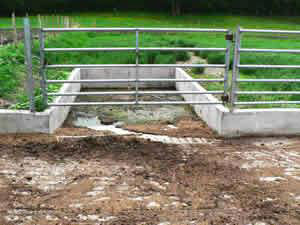Runoff Control from Barnyards and Feedlots
Introduction
Runoff management allows dairy farmers to direct rainwater and/or other runoff water away from their manure storage facilities and confined animal feeding areas. Benefits from runoff control include but are not limited to:
- Avoidance of stream pollution by phosphorus and other potential pollutants
- Reduced manure storage
- Reduced costs related to manure handling and land application
- Improved animal health through reducing food disease and other ailments
Managing Runoff
Careful planning, to determine the location and size of the barnyard/feedlot, helps to minimize the risk of water entering the barnyard/feedlot as well as the amount of water running off from a precipitation event and the potential for pollution. The barnyard/feedlot needs to be on a surface that can be cleaned so that manure may be removed. This limits the quantity of manure that could potentially be washed off. Providing a hard surface allows the cleaning operation to be done without forming pockets that can collect leachate or change the runoff flow.
The runoff water should be collected so that it can be stored or treated. If it is to be stored, gravity flow to an appropriately sized waste storage facility is preferred. If the runoff will be treated, pretreatment, by settling to remove most of the solids, and topography are suitable for improved barnyard/feedlot construction.
Various management practices are available to collect and/or treat the runoff from barnyards and feedlots. Water that comes in contact with animal manure must be handled as waste.
The following examples can keep water clean and prevent it from entering the barnyard/feedlot:
- Roof gutters
- Surface water diversions
- Drip trenches
The following management practices can be used to divert runoff from roof gutters and paved areas away from animal areas:
- Grass filter buffers
- Sediment basins
- Diversions
- Subsurface drainage
- Evaporative or shallow holding ponds in drier conditions.
A constructed wetland can trap any solids or other pollutants carried by runoff before being allowed to enter streams or other sensitive areas. Less water in the barnyard/feedlot decreases the velocity and carrying capacity of flows in the area, resulting in less detachment of manure particles.

Runoff settling basin
Less flow also slows the water, which can allow manure particles to settle where a sediment trap is designed into the runoff management system.
As a result of installing BMPs to reduce runoff, the feedlots and loafing areas will be drier, allowing farmers to manage their daily operations more easily. Animal health can improve due to reduced foot disease and other ailments.
Note Proper runoff management can result in:
- Avoidance of stream pollution by phosphorus and other potential pollutants.
- Reduced manure storage.
- Reduced costs related to manure handling and land application.
- Improved animal health through reducing food disease and other ailments.
Roof gutters, surface water diversions and drip trenches can keep water clean, and away from the barnyard.
Resources
Wright, P. Barnyard/Feedlot Runoff Management. Natural Resources Conservation Service. http://www.cost869.alterra.nl/SERA17_BMP/BMP_barnyard_feedlot.pdf
USGS. 1998. Effectiveness of Barnyard Best Management Practices in Wisconsin. USGS Fact Sheet FS-051-98 http://wi.water.usgs.gov/pubs/FS-051-98/
Conservation Practices Minnesota Conservation Funding Guide. Feedlot Runoff Control System. http://www.mda.state.mn.us/protecting/conservation/practices/feedlotrunoff.aspx
Conservation Practices Minnesota Conservation Funding Guide . Roof Runoff Management. http://www.mda.state.mn.us/protecting/conservation/practices/roofrunoff.aspx
For more information visit the UMass Extension Crops, Dairy, Livestock & Equine Program
Factsheets in this series were prepared by, Masoud Hashemi, Stephen Herbert, Carrie Chickering-Sears, Sarah Weis, Carlos Gradil, Steve Purdy, Mark Huyler, and Randy Prostak, in collaboration with Jacqui Carlevale.
This publication has been funded in part by the Massachusetts Department of Agricultural Resources and the Massachusetts Farm Bureau Federation, Inc.